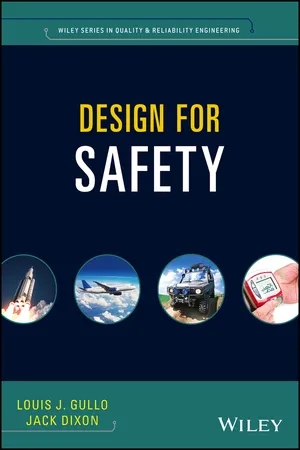
- English
- ePUB (mobile friendly)
- Available on iOS & Android
Quality and Reliability Engineering Series
About This Book
A one-stop reference guide to design for safety principles and applications
Design for Safety (DfSa) provides design engineers and engineering managers with a range of tools and techniques for incorporating safety into the design process for complex systems. It explains how to design for maximum safe conditions and minimum risk of accidents. The book covers safety design practices, which will result in improved safety, fewer accidents, and substantial savings in life cycle costs for producers and users. Readers who apply DfSa principles can expect to have a dramatic improvement in the ability to compete in global markets. They will also find a wealth of design practices not covered in typical engineering books—allowing them to think outside the box when developing safety requirements.
Design Safety is already a high demand field due to its importance to system design and will be even more vital for engineers in multiple design disciplines as more systems become increasingly complex and liabilities increase. Therefore, risk mitigation methods to design systems with safety features are becoming more important. Designing systems for safety has been a high priority for many safety-critical systems—especially in the aerospace and military industries. However, with the expansion of technological innovations into other market places, industries that had not previously considered safety design requirements are now using the technology in applications.
Design for Safety:
- Covers trending topics and the latest technologies
- Provides ten paradigms for managing and designing systems for safety and uses them as guiding themes throughout the book
- Logically defines the parameters and concepts, sets the safety program and requirements, covers basic methodologies, investigates lessons from history, and addresses specialty topics within the topic of Design for Safety (DfSa)
- Supplements other books in the series on Quality and Reliability Engineering
Design for Safety is an ideal book for new and experienced engineers and managers who are involved with design, testing, and maintenance of safety critical applications. It is also helpful for advanced undergraduate and postgraduate students in engineering.
Design for Safety is the second in a series of "Design for" books. Design for Reliability was the first in the series with more planned for the future.
Frequently asked questions
Information
1
Design for Safety Paradigms
1.1 Why Design for System Safety?
1.1.1 What Is a System?
1.1.2 What Is System Safety?
1.1.3 Organizational Perspective
1.2 Reflections on the Current State of the Art
Table of contents
- Cover
- Title Page
- Table of Contents
- Preface
- Acknowledgments
- Introduction: What You Will Learn
- 1 Design for Safety Paradigms
- 2 The History of System Safety
- 3 System Safety Program Planning and Management
- 4 Managing Risks and Product Liabilities
- 5 Developing System Safety Requirements
- 6 System Safety Design Checklists
- 7 System Safety Hazard Analysis
- 8 Failure Modes, Effects, and Criticality Analysis for System Safety
- 9 Fault Tree Analysis for System Safety
- 10 Complementary Design Analysis Techniques
- 11 Process Safety Management and Analysis
- 12 System Safety Testing
- 13 Integrating Safety with Other Functional Disciplines
- 14 Design for Reliability Integrated with System Safety
- 15 Design for Human Factors Integrated with System Safety
- 16 Software Safety and Security
- 17 Lessons Learned
- 18 Special Topics on System Safety
- Appendix A: Hazards Checklist
- Appendix B: System Safety Design Verification Checklist
- Index
- End User License Agreement